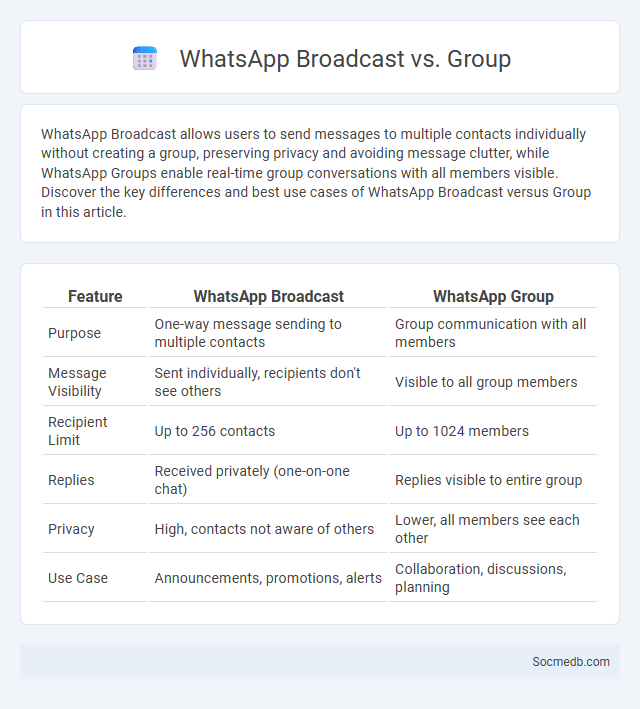
Photo illustration: WhatsApp Broadcast vs Group
WhatsApp Broadcast allows users to send messages to multiple contacts individually without creating a group, preserving privacy and avoiding message clutter, while WhatsApp Groups enable real-time group conversations with all members visible. Discover the key differences and best use cases of WhatsApp Broadcast versus Group in this article.
Table of Comparison
| Feature | WhatsApp Broadcast | WhatsApp Group |
|---|---|---|
| Purpose | One-way message sending to multiple contacts | Group communication with all members |
| Message Visibility | Sent individually, recipients don't see others | Visible to all group members |
| Recipient Limit | Up to 256 contacts | Up to 1024 members |
| Replies | Received privately (one-on-one chat) | Replies visible to entire group |
| Privacy | High, contacts not aware of others | Lower, all members see each other |
| Use Case | Announcements, promotions, alerts | Collaboration, discussions, planning |
Introduction to WhatsApp Communication Features
WhatsApp offers versatile communication features including instant messaging, voice and video calls, and multimedia sharing, which enhance real-time interaction. Its end-to-end encryption ensures your conversations remain private and secure. Group chats and status updates provide dynamic ways to connect and share moments with friends, family, and colleagues on a global scale.
What is WhatsApp Broadcast?
WhatsApp Broadcast is a feature that allows users to send messages to multiple contacts simultaneously without creating a group chat. Each recipient receives the message individually, maintaining privacy and preventing responses from being visible to others. This tool is widely used for marketing, announcements, and personal updates, enhancing communication efficiency while preserving one-on-one interaction.
What is a WhatsApp Group?
A WhatsApp Group is a feature within the WhatsApp messaging app that enables multiple users to communicate simultaneously in a shared chat environment. It allows you to send text messages, images, videos, and voice notes to all members, facilitating seamless group communication. WhatsApp Groups are commonly used for coordinating events, sharing updates, and maintaining social or professional connections efficiently.
What is WhatsApp Contact Sharing?
WhatsApp contact sharing is a feature that allows users to quickly exchange phone numbers and contact information within chat conversations. This functionality enables seamless communication by letting users send a saved contact directly, avoiding manual entry and reducing errors. It optimizes networking and connectivity by integrating contact details into WhatsApp's secure messaging environment.
Key Differences: Broadcast vs Group vs Contact Sharing
Broadcast messaging on social media allows users to send one-way updates to a large, often public audience, ideal for announcements and promotions. Group sharing facilitates interactive communication among multiple members, fostering collaboration and community engagement within a defined circle. Contact sharing is a private, one-to-one exchange of information or media between specific users, ensuring personalized and direct communication.
Advantages and Disadvantages of Broadcast Lists
Broadcast lists on social media allow users to send messages to multiple recipients simultaneously, increasing efficiency and ensuring consistent communication without revealing recipients to each other. They help maintain privacy and reduce group chat clutter, making them ideal for marketing campaigns, event notifications, and personalized outreach. However, broadcast lists can limit interactive engagement and may lead to messages being marked as spam if recipients feel overwhelmed or uninterested.
Pros and Cons of WhatsApp Groups
WhatsApp groups facilitate seamless communication and instant information sharing among friends, family, or colleagues, enhancing collaboration and social connectivity. However, they can lead to information overload and privacy concerns due to unsolicited messages and data exposure within larger groups. Effective moderation and clear group rules are essential to maximize the benefits and minimize drawbacks of WhatsApp group interactions.
Use Cases for Contact Sharing on WhatsApp
Contact sharing on WhatsApp streamlines communication by enabling users to quickly exchange phone numbers without manual entry, enhancing connectivity and reducing errors. Businesses leverage this feature to share customer support contacts, facilitating immediate assistance and improving client engagement. You can seamlessly share multiple contacts in bulk during group chats or networking events, boosting collaboration and outreach efficiency.
Choosing the Best Tool for Communication Needs
Selecting the ideal social media platform depends on your target audience, communication goals, and content type. Tools like Instagram excel in visual storytelling, while LinkedIn is suited for professional networking and business updates. Analyze your audience demographics and engagement patterns to ensure you choose the tool that maximizes your communication effectiveness.
Conclusion: Making the Most of WhatsApp Features
Maximizing WhatsApp features enhances communication efficiency and user engagement through tools like voice messages, group chats, and end-to-end encryption. Leveraging WhatsApp Business functionality enables personalized customer interactions and streamlined service delivery. Consistent updates and integration with other platforms ensure WhatsApp remains a versatile asset in digital communication strategies.
 socmedb.com
socmedb.com